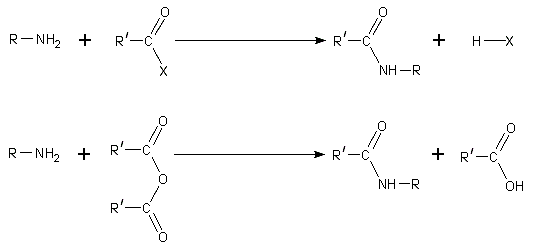Hydrogen bonding significantly influences the properties of primary and secondary amines. Thus the boiling point of amines is higher than those of the corresponding phosphines, but generally lower than those of the corresponding alcohols. Thus methylamine and ethylamine are gases under standard conditions, whereas the corresponding methyl alcohol and ethyl alcohols are liquids. Gaseous amines possess a characteristic ammonia smell, liquid amines have a distinctive "fishy" smell.
Also reflecting their ability to form hydrogen bonds, most aliphatic amines display some solubility in water. Solubility decreases with the increase in the number of carbon atoms. Aliphatic amines display significant solubility in organic solvents, especially polar organic solvents. Primary amines react with ketones such as acetone, and most amines are incompatible with chloroform and carbon tetrachloride.
The aromatic amines, such as aniline, have their lone pair electrons conjugated into the benzene ring, thus their tendency to engage in hydrogen bonding is diminished. Their boiling points are high and their solubility in water low
Chirality
Amines of the type NHRR' and NRR'R" are chiral: the nitrogen atom bears four substituents counting the lone pair. The energy barrier for the inversion of the stereocenter is relatively low, e.g., ~7 kcal/mol for a trialkylamine. The interconversion of the stereoisomers has been compared to the inversion of an open umbrella in to a strong wind. Because of this low barrier, amines such as NHRR' cannot be resolved optically and NRR'R" can only be resolved when the R, R', and R" groups are constrained in cyclic structures such as aziridines. Quaternary ammonium salts with four distinct groups on the nitrogen are capable of exhibiting optical activity.
Properties as bases
Like ammonia, amines are bases. Compared to alkali metal hydroxides, amines are reasonably weak (see table for examples of conjugate acid Ka values). The basicity of amines depends on:
- The electronic properties of the substituents (alkyl groups enhance the basicity, aryl groups diminish it).
- Steric hindrance offered by the groups on nitrogen.
- The degree of solvation of the protonated amine.
The nitrogen atom features a lone electron pair that can bind H+ to form an ammonium ion R3NH+. The lone electron pair is represented in this article by a two dots above or next to the N. The water solubility of simple amines is largely due to hydrogen bonding between protons on the water molecules and these lone electron pairs.
- Inductive effect of alkyl groups
| Ions of compound | Kb |
| Ammonia NH3 | 1.8·10−5 M |
| Propylamine CH3CH2CH2NH2 | 4.7·10−4 M |
| 2-Propylamine (CH3)2CNH2 | 3.4·10−4 M |
| Methylamine CH3NH2 | 4.4·10−4 M |
| Dimethylamine (CH3)2NH | 5.4·10−4 M |
| Trimethylamine (CH3)3N | 5.9·10−5 M |
- +I effect of alkyl groups raises the energy of the lone pair of electrons, thus elevating the basicity. Thus the basicity of an amine may be expected to increase with the number of alkyl groups on the amine. However, there is no strict trend in this regard, as basicity is also governed by other factors mentioned above. Consider the Kb values of the methyl amines given above. The increase in Kb from methylamine to dimethylamine may be attributed to +I effect; however, there is a decrease from dimethylamine to trimethyl amine due to the predominance of steric hindrance offered by the three methyl groups to the approaching Lewis acid.
- Mesomeric effect of aromatic systems
| Ions of compound | Kb |
| Ammonia NH3 | 1.8·10−5 M |
| Aniline C6H5NH2 | 3.8·10−10 M |
| 4-Methylaniline 4-CH3C6H4NH2 | 1.2·10−9 M |
| 2-Nitroaniline | 1.5·10−15 M |
| 3-Nitroaniline | 2.8·10−13 M |
| 4-Nitroaniline | 9.5·10−14 M |
- -M effect of aromatic ring delocalises the lone pair of electrons on nitrogen into the ring, resulting in decreased basicity. Substituents on the aromatic ring, and their positions relative to the amine group may also considerably alter basicity as seen above.
- The degree of solvation of protonated amines:
| Ions of compound | Maximum number of H-bond |
| NH4+ | 4 Very Soluble in H2O |
| RNH3+ | 3 |
| R2NH2+ | 2 |
| R3NH+ | 1 Least Soluble in H2O |
In sterically hindered amines, as in the case of trimethylamine, the protonated form is not well-solvated. For this reason the parent amine is less basic than expected. In the case of aprotic polar solvents (like DMSO and DMF), wherein the extent of solvation is not as high as in protic polar solvents (like water and methanol), the basicity of amines is almost solely governed by the electronic factors within the molecule.









